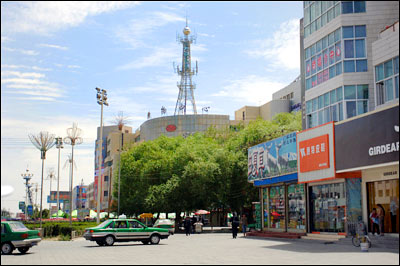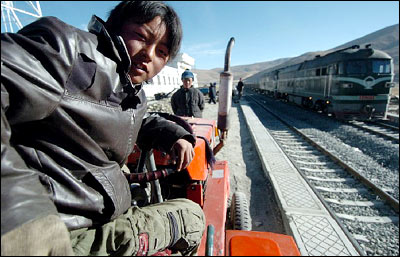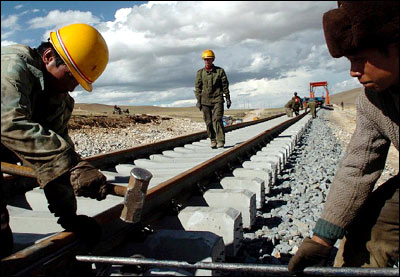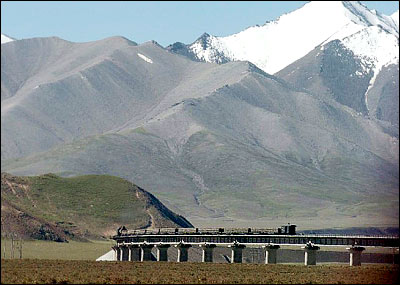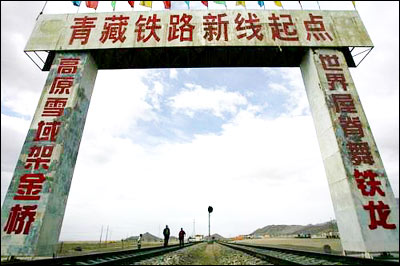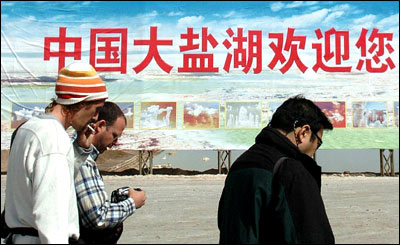| Tools: Save | Print | E-mail | Most Read |
| Golmud - Lost in Transportation |
| Adjust font size: |
At last they came to the edges of the Gobi in southwest China. After five years of toil and sweat, they brought liveliness, fervor and fortune to a place oft forgotten. Until July 1, 2006, this town came to its senses slowly, the hustle and bustle that perpetually inhabited it now vanished, leaving behind it a railroad. The railroad to Lhasa. Welcome to Golmud. In Mongolian, Golmud means "a place abundant in rivers". Located to the south of the central Qaidam Basin, in the west of Qinghai Province, Golmud has developed into the third biggest city on the Qinghai-Tibet Plateau, after Xining and Lhasa. When including the Hoh Xil nature reserve, Golmud can boast as being "the city with the largest prefecture in the world." While downtown Golmud covers an area of 20 square kilometers, it is home to a multi-ethnic population of more than 200,000 Han, Mongolian and Hui people. As a city, Golmud's history spans only 50 years. In the 1950s, General Mu Shengzhong was assigned to investigate the possibility of building a railway on the Qinghai-Tibet Plateau. As the troops crossed the desert, a call was heard asking when they would arrive at this place apparently so abundant in rivers. Mu planted the sign bearing the word "Golmud" into the ground, hailing that there it was to be. Before then, Golmud had been a place only visited by ancient Mongolian herdsmen. Indeed, it only became an official city on June 14, 1980. Today, with 90 percent of its population coming from outside, it is known as the city of immigrants.
Over the last half-century, Golmud, formerly a military transportation base, gradually grew to becoming the main entrance to Tibet, the only land route across the Qinghai-Tibet Plateau by which materials and goods were carried to Lhasa. For decades, automobiles had been the city's lifeline. Until that fateful day in 2001 when the railway construction workers came. Overnight, the streets filled with people, altering the town's characteristics forever. Prices soared, taxis became scarcer and harder to find while restaurants and beauty salons mushroomed in every street. According to the local government, Golmud's GDP soared from 16.8 billion yuan in 2000 to 56.73 billion yuan in 2005 with a yearly 21.2 percent average increase. Sadly, the good times did not last long. At the end of 2005, the railway workers left, taking away with them the city's fervor and joy. Trains passed by endlessly and Golmud dwindled to become nothing more than a name on the station board. Although the Qinghai-Tibet Railway has finally been completed, Golmud City seems to be out of touch with the entire world. According to Lamao Jiancuo, deputy secretary of the Golmud Municipal Party Committee, 75 percent of goods transportation coming in and out of Tibet would be replaced by train with highway freight transportation down by 80 percent. 53-year-old Liu Xuewen from Xining, capital of Qinghai Province, is a taxi driver who came to Golmud in 2004. "I have a son who also drives a cab in the city and business has become rather tough now due to the opening of the railway." Prior to the railway, Liu could earn 300-400 yuan each day but now he has seen his earnings drop to just over 100 yuan a day. Several of his friends have already left the city. "I'll probably go back home before the Spring Festival next year and not come back again," Liu added, saying that like many others, he might drift to Lhasa or into southern China, in search of better opportunities and a better life. Both the flow of humans and of goods will tarry now that Golmud's function as a transfer town has trickled to a halt. Zhu Jianping, mayor of Golmud, admitted that the Qinghai-Tibet Railway had had a great impact on Golmud's industrial structures, finance, tertiary industries and employment. The Qaidam Basin holds more than 30 kinds of commodities available to be mined as well as 605 deposits beds. It possesses China's largest reserves of lithium, sylvite, magnesium salts and sodium salt as well as possessing China's second largest reserve of boron rock. The opening of the Qinghai-Tibet Railway would actually allow these abundant underground resources to be put into use. Qinghai has also planned to build several goods distribution and supply centers in Xining, Golmud, and Delinha as part of the province's future five-year plan. The "Distribution Economy" has struck out in a brand new direction of development for both Qinghai and Golmud itself.
(China.org.cn by staff reporter Li Xiao, August 21, 2006) |
| Tools: Save | Print | E-mail | Most Read |
 |
| Related Stories |
| Product Directory China Search |
Country Search Hot Buys |
